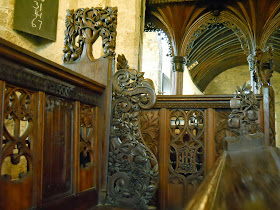St Carantoc's in situated in the small village of Crantock in Cornwall. There has been a church on the site since one was founded there by Carantoc in about the 5th century. He was the eldest son of a Welsh chieftain and had given up his succession, studied under St Patrick in Ireland and is reputed to have sailed from there to this area in a coracle.
The church is basically of Norman design, although there has been much rebuilding; the tower, nave and many other parts were rebuilt in the 15th century after the previous tower had become neglected and collapsed (bringing down much of the church with it). The South Porch dates to the 17th century.
St Carantoc's was the centre for a college of priests after being granted a charter by King Edward the Confessor. This made it quite powerful and the mother church for a large area around it. The Eastern end of the building is higher and wider than the Western end (as you can see in the picture above) because the monks of the college worshipped in one end whereas the poorer parishioners used the other. I'm sure that you can guess who got which end!
The college of priests was disbanded during the Reformation in the 16th century and the building gradually fell into disrepair, with the Puritans no doubt helping the process along. There were some attempts at restoring it in the 18th century, although they were fairly shoddy.
The current state of repair is basically down to one man: George Metford Parsons, who became vicar there in 1894 and remained vicar until his death in 1924. He campaigned for funds to renovate the building in 1897 and by 1907 the work was done and pretty much paid for. The architect for the renovation was Edmund Harold Sedding and he did a very good job, with any surviving pieces of high-quality older woodwork being incorporated into the newly restored church furniture or being displayed in an arrangement at the back of the church. Fifteen new stained glass windows were also installed at the time.
Sedding was buried in the churchyard at St Carantoc's after his death.
My first reaction on entering the church was amazement at the unexpectedly high quality of the woodcarving to be seen. The rood screen and choir stalls in particular are stunningly well executed.
(One piece of work in the church that was carved elsewhere is the crucifixion scene on the rood screen, which was produced by some of the famous woodcarvers of Oberammergau in Bavaria and mounted atop the screen afterwards.)
This was the first time that I had knowingly come across Violet Pinwill's work. She sounds like she was a very remarkable person.
 |
| Image from search.ancestry.com |
They decided to go into business and formed the company Rashleigh Pinwill, basing themselves in Plymouth in Devon. The company specialised in supplying carvings based on natural forms to churches in Devon and Cornwall. When Mary and then Ethel left, after some time, Violet continued to head the company under the name V. Pinwill Carvers. She employed several male carvers but also executed a lot of the carved work herself.
Violet Pinwill died in Plymouth in 1957, aged 83. She left carvings in wood and stone in over 100 churches in Devon and Cornwall, including Truro cathedral. It may be worth remembering that the Pinwill sisters formed and led this highly successful company of woodcarvers at a time when women in Britain were not even allowed to vote.
Ed Hall, maker of trade union banners, noted in the programme for the Dismaland exhibition that he particularly likes banners made by the Suffragettes. He makes an interesting point about women working at this time in British history:
'The interesting thing about the Suffragettes is that one or two of them, including Sylvia Pankhurst, were artists in their own right - women were excluded from many professions but there was no bar to them joining the arts so some of the Suffragette banners were professionally made.'
Behind the church is a small roofed structure containing a woodcarving in oak by Davey and Bushell, who were based in Bristol. The panel was carved sometime between 1900 and 1919.
It accompanies the old stocks for Crantock and relates the tale of the last man to be held in them.
The carved story reads like this:
'The last man in Crantock stocks (circa. 1817) was William Tinney of West Pentire, a smuggler's son and a vagabond. He robbed, with violence, a widow woman of Cubert parish and was placed, to abide justice, in Crantock stocks, then standing in the church tower. By negligence or design he was insufficiently secured and shortly afterwards appeared on the top of the tower. He had cut the rope from the tenor bell and by this he lowered himself to the nave roof. Climbing to the eastern gable of the choir and sliding down it, he dropped to the churchyard grass and in the sympathetic view of certain village worthies bolted, got off to sea and was never brought to justice or seen in the neighbourhood again.
This record was taken down in April 1896 by George Metford Parsons, vicar, from the testimony of Richard Chegwhidden of Crantock, he being then 88 years of age and well remembering as a witness the events described.'
' I paid my price for finding out,
Nor ever grudged the price I paid,
But sat in clink without my boots,
Admiring how the world was made.'















A fascinating article.
ReplyDeleteI'm glad that you have enjoyed it and thank you for posting
ReplyDelete